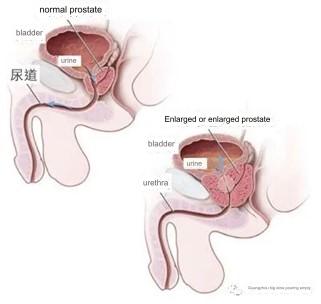As society pressure increases, men's health problems have become increasingly prominent. Among them, the prostate, an organ unique to men, is significantly highlighted affecting men's health. Therefore, let’s learn things about prostate enlargement.
What is prostatic hyperplasia?
The prostate is the largest solid organ among the male genital accessory glands and is composed of both prostate tissue and muscle. Its bottom is facing upward, close to the bladder, and its tip is facing downward, touching the urogenital diaphragm. The front is attached to the pubic symphysis, and the back is attached to the rectum. The prostate gland guards the upper urethra, so if something goes wrong with the prostate, urination will be the first to be affected.
The prostate develops to its peak around the age of 25, and its volume is relatively constant between the ages of 30 and 45. After the age of 45 to 50, due to factors such as the disordered secretion of male hormones in old age, it slowly begins to become "fat" and its volume begins to increase, that is, prostate hyperplasia.

Prostatic hyperplasia, also known as benign prostatic hyperplasia, is one of the common diseases seen in elderly men. Sedentary, urine holding, testicular factors and androgen metabolism disorders may lead to the occurrence of the disease.
The most common early symptom is frequent urination, most notably nocturia . Normal people usually urinate 0-1 times at night. Patients with prostatic hyperplasia will significantly increase the number of nocturia, some may reach 4 or 5 times, and some may even reach more than 10 times.
Tnother obvious symptom of prostatic hyperplasia - difficulty urinating , which manifests as urine waiting, thinner urinary line, weak and short range of urination, labored urination, dribbling of urine, incomplete urination, etc.
Prostatic hyperplasia may cause an increase in residual urine volume in the bladder, leading to urinary reflux, which may in turn cause ureteral dilatation, hydroureter, and kidney water accumulation. In severe cases, it may even lead to chronic renal failure, which is life-threatening.
Therefore, once you suffer from prostate hyperplasia, you must go to a regular hospital for treatment.
How is prostate hyperplasia treated?
Current treatments for prostatic hyperplasia mainly include drug therapy, surgery and minimally invasive interventional therapy.
drug treatment is to relieve the patient's lower urinary tract symptoms, and the long-term goal is to delay the clinical progression of the disease.
Surgical treatments include traditional prostatectomy and transurethral resection or ablation of the prostate. Both procedures have disadvantages such as greater trauma, need to be performed under general anesthesia, and many postoperative complications. For those with chronic diseases involving the heart, lungs, liver and kidney, the risks of surgery are even higher.
Interventional treatment uses prostatic artery embolization (PAE), which has the advantages of less trauma, significant curative effect, and fewer complications. It is not only suitable for ordinary symptomatic patients, but can also be used for the elderly and those with heart, lung, liver and kidney problem.
How to prevent prostate hyperplasia?
Prostatic hyperplasia is a benign disease, and early intervention can help prevent serious complications and improve quality of life. In daily life, patient should change his living habits, drinking more water, eating less spicy food, quitting smoking and limiting alcohol consumption, avoiding sedentary, holding in your urine less, etc. In addition, because the incidence of prostate hyperplasia is proportional to age, the older the easier to suffer from prostatic hyperplasia. Therefore, it is recommended that men over 50 years old should have regular prostate examinations and seek for medical help if signs of hyperplasia such as frequent urination, increased nocturia, or difficulty urinating show.